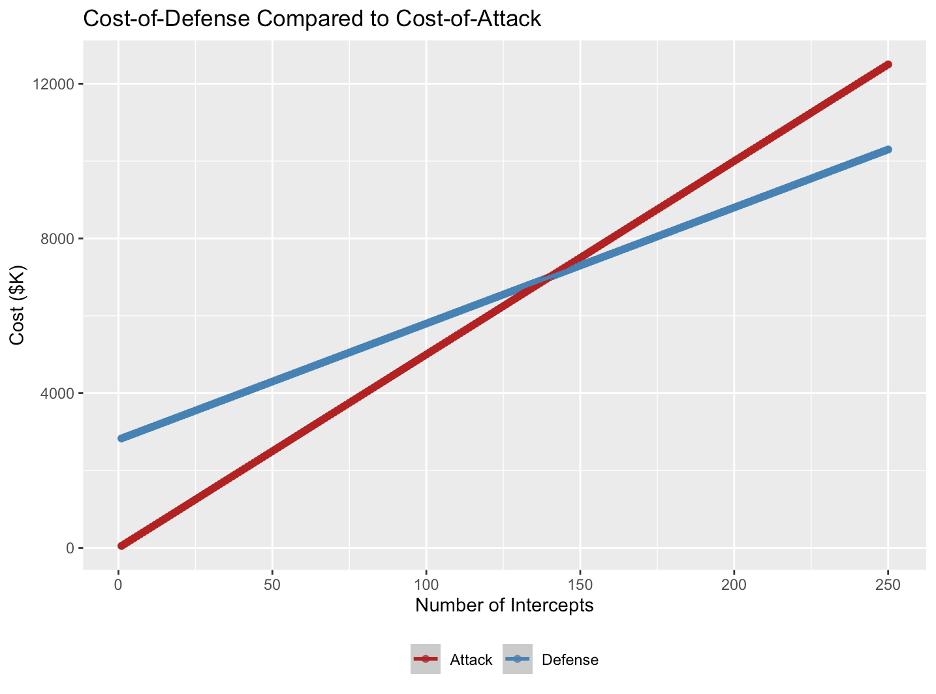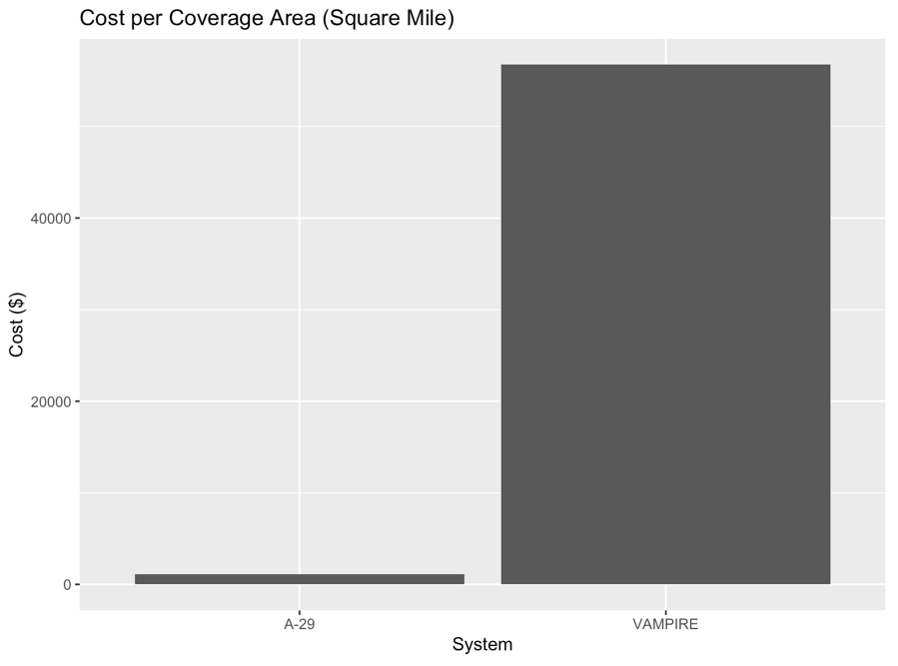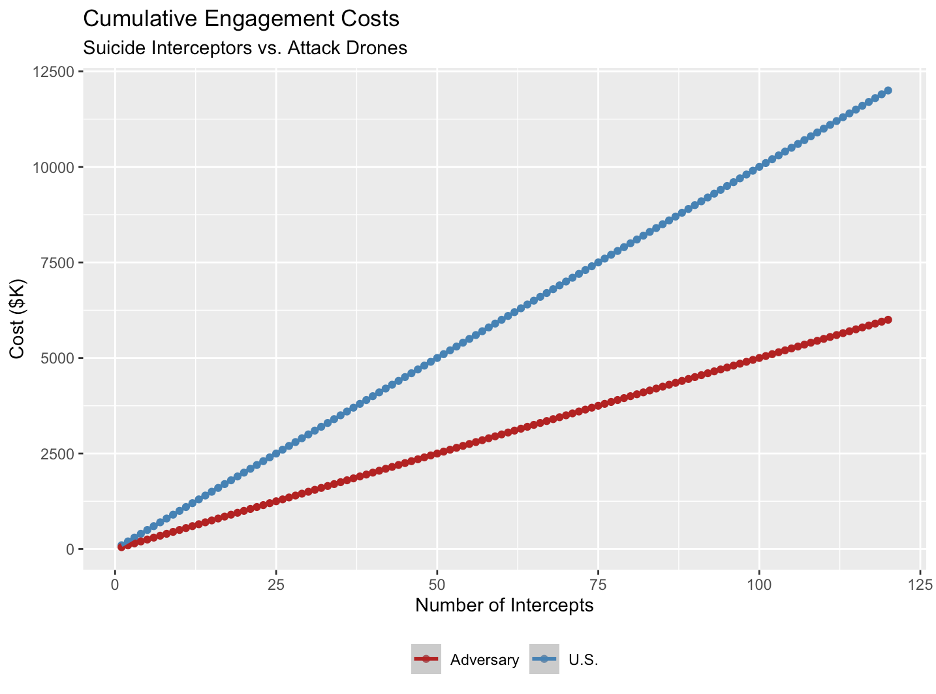Join War on the Rocks and gain access to content trusted by policymakers, military leaders, and strategic thinkers worldwide.


The United States lost the war against a weapon that almost everyone knows by its acronym: the IED or improvised explosive device. Despite technological innovation, training, and tactical brilliance, attacks persisted. Tactical adaptations failed to prevent strategic defeat. IED components remained cheap and ubiquitous. Manufacturing knowledge spread faster than defenses could adapt. Most critically, the countermeasures never managed to close the risk-cost imbalance. Each new or improved defensive kit pushed the United States deeper into a cost trap.
Listening to today’s military and industry discussions on counter-drone strategies, it feels like déjà vu. As the Army’s chief technology officer warned in a recent War on the Rocks podcast episode focused on the Army’s counter-drone initiatives, “IEDs fly now, and they fly at 100 miles an hour.” The current counter-drone strategy borrows heavily from the counter–IED three-pillar playbook: attack the network, defeat the device, and prepare the force. Yet, if the counter-IED campaign ended in strategic defeat, is it wise to replicate its framework for counter-drone operations? To answer this question, the U.S. armed forces should first identify how drones differ from improvised explosives and determine whether a proactive or reactive approach best fits the threat and how drones interact with current military missions.
Déjà Vu
In Iraq and Afghanistan, the war against IEDs was a war within the war. At first, few grasped the profound impact that a crude bomb buried in the dirt or hidden in a pile of trash would have on two decades of combat and the character of war. The early roadside bombs were simple: an artillery shell, a pressure plate, and a few wires. Then came greater sophistication with the inclusion of shaped charges and remote triggers, such as cell phones. No route was safe — IEDs appeared beneath culverts, inside animal carcasses, even under roads coalition engineers had just paved. The enemy did not need to win decisive firefights. They only needed to make convoys feel hunted.
The United States responded with a torrent of money and ingenuity, pouring billions into solutions and standing up the Joint IED Defeat Organization. Armored Humvees gave way to expensive, hulking mine-resistant ambush protected vehicles (commonly known as MRAPs), whose V-shaped hulls were designed to deflect blasts. Electronic jammers became standard features for vehicles, and electronic warfare platforms flew convoy overwatch. Units trained to spot disturbed earth, suspicious trash, or tripwires, all while moving through villages where any inhabitant could be a bomber or a spotter. The innovations and initiatives saved lives, but they never flipped the cost-risk equation. IED attacks persisted.
Each time the United States fielded a new sensor, jammer, or armor kit, insurgents shifted tactics seemingly overnight. Most American adaptations required contracts, production lines, and fielding cycles that stretched for months. The result was a grinding, asymmetric duel: one side learning through experimentation and improvisation, the other through procurement orders and PowerPoint briefings. By the time the U.S. military perfected its countermeasures, the battlefield was already changed. With a 1000:1 cost ratio, the enemy succeeded through cost imposition: It was far more expensive to defend than to attack.
In the end, the IED campaign revealed an uncomfortable truth. Technology can blunt the impact of a threat, but it cannot compensate for an adversary who adapts faster and spends less.
The slow recognition of the changing character of warfare and the rapid innovation cycle of the adversary is eerily similar to the rise of drones on the battlefield. The drone threat mirrors the IED’s asymmetric cost dynamic.
That dynamic is what makes today’s counter-drone conversation feel like déjà vu. The Defense Department’s counter-drone strategy rests on five pillars: deepen understanding and awareness of trends and threats, disrupt and degrade threat networks, defend against threats, deliver solutions at speed and scale, and develop and design a force for unmanned systems warfare. Succinctly, the framework expands upon the three-pillar counter-IED approach and formalizes the need for rapid acquisitions.
To determine whether adopting a well-worn strategy is warranted, it is instructive to examine the similarities and differences between IEDs and drones. Both are ubiquitous on modern battlefields due to a single overarching attribute: cost asymmetry. Each benefit from an abundance of dual-use civilian components that enable scalable manufacturing and proliferation while complicating interdiction and control efforts. Technical know-how diffuses easily across the battlespace and, as with IEDs, effective drone defense still depends on well-prepared forces, intelligence fusion, and disciplined training.
Colloquially known in some circles as “the poor man’s air force,” drones deliver aerial effects once reserved for traditional militaries. All air forces rely on aerial platforms for reconnaissance and interdiction, but drones offer these capabilities at a fraction of the cost. Compared with a traditional air force consisting of manned aircraft, drones trade individual flexibility and platform capability for sheer volume and distribution.
Drones deliver a key capability over IEDs: the ability to hunt for targets. Whereas IEDs acted as ambush predators, emplaced along predictable routes, drones can search for and approach targets from multiple directions, erasing the perceived safe rear area. Drones extend area denial and constrain maneuver more effectively than IEDs or mines.
Drone networks also differ from IED networks in the number of key individuals involved. IED bombmakers were required to manufacture the devices, even though components were easy to obtain. In contrast, many drone systems draw from a mature global supply chain and require only simple assembly or modification. This shifts the importance from the manufacturer to the operator, specifically, the drone pilot. While skill levels vary, the gap between novice and expert drone pilots is narrower than among bombmakers, considering there are more prospective pilots. Drone piloting suits gamers well, and advanced simulators can speed up training. As autonomy improves, the significance of individual pilot skill will matter even less.
Given these realities, the effectiveness of attacking the drone network offers limited strategic payoff. China alone accounts for roughly 90 percent of the global drone supply chain and manufactures tens of millions of drones annually. Beijing’s economic leverage and divergence from U.S. priorities make interdiction or cooperation unlikely amidst the trade war, strategic misalignment, and the resultant decoupling. Consequently, at least one of the three classic counter-IED pillars appear ill-suited for the drone challenge.
Ironically, the drone’s ability to range targets inverts the traditional defense cost equation. With IEDs, troops had to travel into enemy territory to be targeted, requiring complex and costly technology to mitigate the threat. Drones, by contrast, can hunt troops into their own rear areas — but counters can be surprisingly simple and inexpensive, such as netting or static barriers. In some contexts, the asymmetric cost advantage may approach parity. For this reason, defeating the device has merit for retention.
Perhaps the largest contributor to reducing IED effectiveness and casualties was through improved training. Training programs prepared troops to identify IED indicators and understand their construction, better coordinate clearance efforts, and enhance tactics that limited their exposure. Countering drones reinforces the importance of preparing the force as a pillar. Rapid changes in tactics, equipment, and countermeasures in Russia and Ukraine are representative of a force that understands their threat and drives a rapid innovation cycle. Without preparation, a force risks being caught flat-footed and taking higher casualties.
Focus on Winnable Strategies
The counter-drone strategy should prioritize preparing the force and defeating the drone (the “device”), as attacking the global supply network is likely unwinnable. The global supply chain is too abundant and mainly controlled by countries whose incentives diverge from U.S. interests, undermining the broad consensus and coalition required for effective arms controls or sanctions. If America pursues a strategy with two winnable lines of effort, explicit objectives should be set for cost, scalability, and operational effectiveness.
Counters need not equalize costs on a per-system basis, but rather on an aggregated interception basis. Reusable systems usually offer the best bang for the buck. For example, L3Harris’ VAMPIRE counter-unmanned weapons system costs approximately $2.85 million and shoots $30,000 rockets for drone defense, while the attacking Shahed-136 drone is estimated to cost around $50,000. The cost-benefit analysis of this defensive purchase depends on the coverage, reliability, and the expected number of interceptions the system can achieve over its service life.
Cheaper options (trading a rocket for a bullet) are attractive cost exchanges, provided this does not disproportionately degrade effectiveness. Gun-based systems offer exceptional cost-per-engagement and simple logistics, provided accurate aiming can be assured. Gun systems that use existing infantry weapons or smaller-caliber rounds are intriguing. Still, first-hit percentages would have to be high to compensate for the lower rate of fire and lack of burst capabilities, especially with maneuvering aerial targets. Therefore, gun systems that use proximity-fused or variable-time rounds are preferred, as they increase the likelihood of hitting the target by compensating for minor tracking errors that would otherwise constitute a near-miss.
Directed-energy weapons, such as lasers and high-powered microwaves, offer very low costs per shot but come with some significant caveats. Such weapons lose effective power by orders of magnitude with distance, rendering them short- to medium-range point-defense systems. Because of the relationship between power loss and distance, the system’s cost increases dramatically with incremental increases in effective range. Also, increases in power requirements come at the expense of mobility, and a thesis performed by the Naval Postgraduate School illustrates the challenges of powering these weapons. In general, high-powered microwaves have a shorter range than laser weapons.
For high-powered microwave systems, shielding can delay or negate damage to electrical components. Reflective or diffusive coatings can delay effects for laser weapons, but must be tailored to the laser weapon’s wavelength. Dwell time can also limit the suitability of laser weapons for a swarm attack. In general, smaller drones are harder to shield and protect against directed-energy weapons because they lack the space and power to accommodate shielding, which also increases their cost. For these reasons, microwave weapons are better suited for close-in protection against multiple, multi-axis lower-end threats, such as first-person-view or repurposed commercial drones. Lasers are effective regardless of coatings – eventually; however, lasers require sufficient power to burn through coatings with enough stored energy for multiple shots. Thus, laser weapons need to be paired with other methods as they risk being overwhelmed if not part of a layered defense.
In the illustrative example below, L3Harris’ VAMPIRE counter-drone system is employed against a Shahed-136 one-way-attack drone. For simplicity, the example omits operations and sustainment costs and assumes a 100 percent engagement success rate. Under those assumptions, the defender’s and attacker’s cost curves intersect at roughly 144 engagements. In the context of a protracted conflict, reusability and low-cost intercept munitions will improve the cost-exchange ratio in the defender’s favor.

Coverage density is also decisive. A VAMPIRE system has an engagement envelope of roughly four nautical miles and can be truck-mounted, whereas an Embraer A-29 Super Tucano light-attack aircraft without external fuel tanks has a combat radius of about 100 nautical miles. Without factoring in repositioning time, road accessibility, or aircraft response delays, the chart below illustrates an order of magnitude difference in coverage cost, showing that aircraft can provide far cheaper area coverage than point defense systems.

Simple, static defenses are often the most cost-effective protection for fixed infrastructure or expeditionary military encampments. Both Ukraine and Russia have used simple netting — sometimes improvised from recycled fishing gear — to protect roadways and vehicles against first-person-view drones, demonstrating how otherwise worthless trash can defeat a $500 drone. Other relatively cheap countermeasures include erecting barriers, such as the famous Hesco barriers used in the desert, to blunt low-angle approaches. When Shahed-type drones approached their infrastructure targets at low altitude, such barriers reduced damage and made interdiction by gunfire easier. Russia eventually adapted its tactics, operating at a higher altitude before executing a steep, high-speed dive to avoid these counters. The new tactics decreased Ukrainian intercept rates for now but provide opportunities for other interception tactics. For example, higher drone transit altitudes provide greater opportunities for aircraft interceptions.
The push to use attritable systems to attack attritable systems, first demonstrated in Ukraine, can be a slippery slope. Ukraine demonstrated success in ramming Russian drones with human-piloted interceptor drones. In the Ukrainian construct, the cost exchange was favorable; however, Western companies are pushing for greater autonomy features, seeking improved effectiveness. Several defense company efforts and concepts for interceptor drones hinge on the success of complex software. Software is notoriously expensive to develop, but once created, it can be downloaded onto numerous platforms, amortizing the upfront software cost across an expanded fleet. A wrinkle is that software can be deceived by simple countermeasures, requiring updates as tactics and operating environments evolve. For example, Russia changed the paint schemes on warships and mounted tires on TU-195 bombers to throw off image-based algorithms. How the overall cost-benefit ratio is affected by these required software updates to regain efficacy, and the timeline for implementation, is unknown.
Another challenge is that most U.S. interceptors are significantly more costly than the systems they are designed to defeat. Over the course of a prolonged conflict, this imbalance can lead to a slow bleed of capability and resources. In the chart below, a notional $100,000 interceptor is used to engage Shahed drones, underscoring the unfavorable cost-exchange ratio. Arguments circulate that a system’s cost relative to a nation’s economy is more important than the comparative cost between the system and the threat it is designed to defeat. Such arguments miss the point, and each dollar consumed represents one lost for another purpose.

By contrast, several developers are pursuing reusable concepts, turning their drones into analog fighter aircraft that shoot down other drones with nets or mounted guns. Such designs represent a circular evolution of aerial warfare and are more likely to sustain a favorable cost-exchange efficiency over time. As a circular evolution, counter-drone missions complement and layer into existing missions of integrated air and missile defense, strike warfare, and offensive or defensive counter-air.
Actions to Take
Preparing the force will yield the greatest dividends in defending against aerial threats. The Survivability Onion is an instructive concept to direct training efforts. First, ensure timely, widely shared intelligence to identify which adversary drone operating areas to avoid. Second, minimize and conceal detectable signatures through infrared-absorbing fabrics, netting, and deliberate movements to reduce detection and targeting susceptibility. Finally, if detected, employ active defenses such as aim-assist gun scopes and mobile point-defense systems. Aircraft would provide interdiction well beyond point defense systems to blunt incoming attacks by thinning numbers before reaching critical areas. In essence, counter-drone needs to be thought of in the context of being layered into traditional mission sets: integrated air and missile defense, strike, and offensive counter-air warfare concepts.
Our analysis suggests that U.S. forces should prioritize reusable firing systems paired with inexpensive interceptors such as modified rockets, gun-fired ordnance, and directed-energy weapons. In the case of directed-energy weapons, it is vital to be cognizant of the tight correlation between effective range, power, and overall cost — making a directed-energy weapon “long-range” risks making a system unaffordable and immobile. A layered approach that integrates both static defenses and point-defense systems with light fighter aircraft offers an optimal balance of coverage and cost-efficiency. As autonomy software matures, shifting to fully autonomous drone interceptor solutions will become increasingly viable, but we still see a need for manned systems for the foreseeable future to ensure responsiveness, adapt to algorithmic countermeasures, and retain human judgment and decision-making.
Beyond the battlefield, soft targets, such as transformer substations and undersea cable landing sites, should at least implement simple protective measures, such as deceptive painting to confuse image-recognition algorithms, netting, and physical barriers. Critical infrastructure targets such as power plants, ports, logistics hubs, and command-and-control or communication nodes warrant the protection of point-defense systems.
Because autonomy is already embedded in many long-range drone systems, electronic jamming is rapidly losing its effectiveness and should be deprioritized relative to kinetic, reusable, and passive defense investments. One thing is for sure: Threats are proliferating, and the American homeland is increasingly exposed. In the competition for finite resources, the United States should be diligent and deliberate in its spending. That means focusing on winning strategies and not equating effective with exquisite or inexpensive with ineffective.
Andrew Tenbusch is a U.S. Navy officer and author.
Trevor Phillips-Levine is a U.S. Navy officer and author. Previously, he advised in cooperative research and development agreements regarding weaponized drones and participated in Defense Innovation Unit unmanned system initiatives.
The opinions expressed are those of the authors and do not reflect the views or positions of the U.S. Navy, the Department of Defense, or any part of the U.S. government.
**Please note, as a matter of house style War on the Rocks will not use a different name for the U.S. Department of Defense until and unless the name is changed by statute by the U.S. Congress.
Image: L3Harris via Wikimedia Commons
